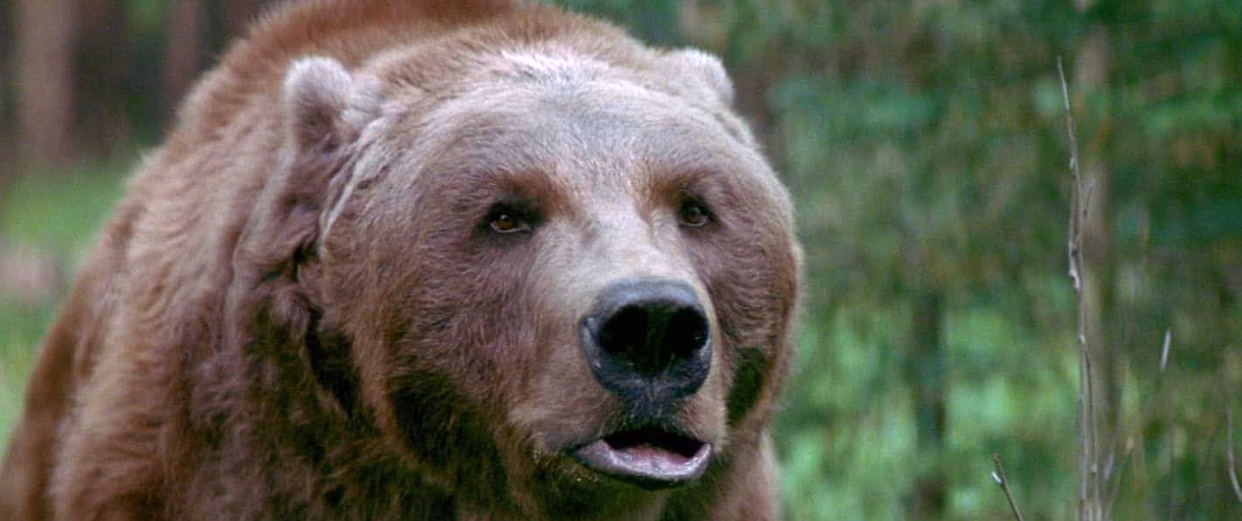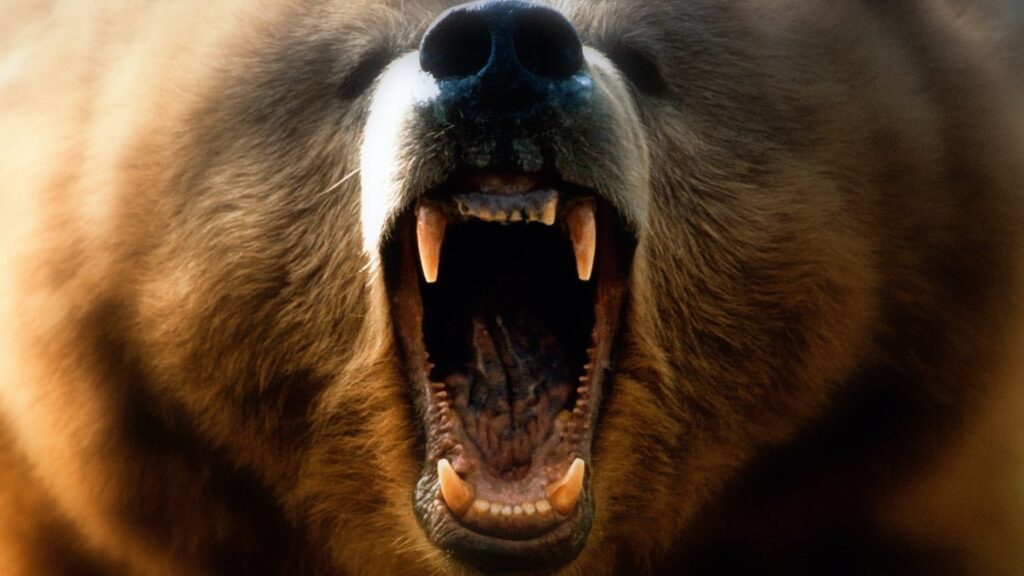
A classic tale of attempting to survive against the odds, The Edge (1997), follows erudite billionaire Charles Morse (Anthony Hopkins),duplicitous photographer Robert Green (Alec Baldwin) and personal assistant Stephen (Harold Perrineau) as they trek through the wilderness pursued by a bear (Bart the Bear). The men are part of a larger group, including Charles’ model girlfriend (Elle MacPherson), on a photoshoot in an isolated part of Alaska. Following a plane crash while on a jaunt to find a local Native American man, who Robert believes to be the perfect subject for his photos, the men find themselves miles from civilization and the comforts of human society. The crash, having been caused by the plane veering into a flock of birds, foreshadows the untamed landscape they are about to find themselves in. The Bear soon comes across the men and a fight to stay alive ensues for both the humans and the animal.
The film is action-packed and full of heart-racing scenes stereotypical of the adventure genre. Unsurprisingly, it was directed by Lee Tamahori who is known for Bond film Die Another Day. Atmospheric establishing shots and harrowing close-ups are frequently used to demonstrate the peril of the human characters. The Edge follows the cliché survival narrative in which the audience are encouraged to root for the human protagonists as they escape from the supposedly evil Bear. It is interesting to view the film from a perspective of animalistic survival as opposed to human survival. We are encouraged as viewers to understand what the people need to stay alive rather than what the animals need. Whereas if we understand that both animals and humans have survival needs it can help us to understand the narrative differently. There is also a sense that the men are not combatting The Bear in a way that is fair. They have entered The Bear’s environment and are attempting to destroy The Bear and the landscape that surrounds it using tools that are not part of the natural world i.e matches. Whereas The Bear is simply using his natural adaptations to survive. It is vital to explore the way that the destruction of animals and habitats is glorified within the narrative.
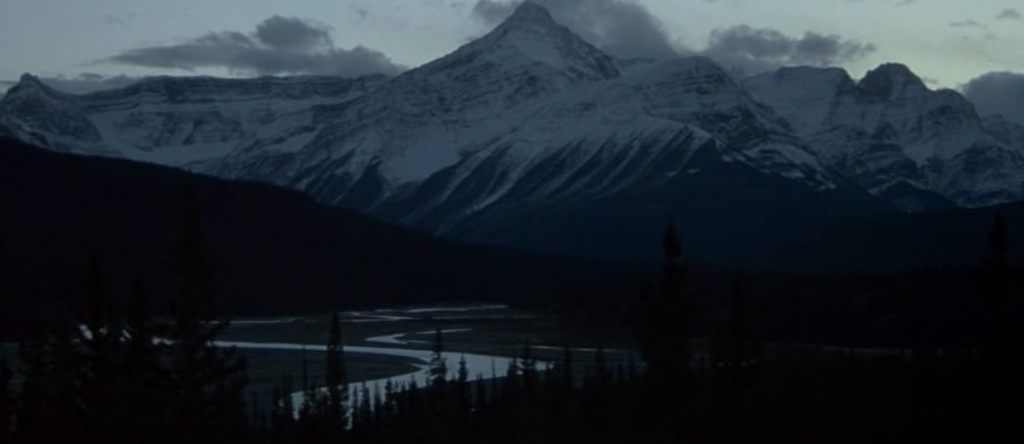
The first time the men come across The Bear they hear a growl followed by a wide-shot of The Bear hurtling towards them. In the background intense, eerie music plays which adds to the sense of danger in the scene. Interestingly, Jerry Goldsmith who composed the film’s soundtrack had previously worked on Congo (1995),a film about a killer ape, so it is unsurprising that he was chosen to score the film. As a viewer, we are encouraged to fear the creature as it hunts down the men and hope that The Bear will soon meet its end. It is hard to not to feel this as around forty minutes into the film we have grown fond of the human characters. We have been encouraged to become emotionally attached to them in order that we feel distressed when The Bear is chasing them. Nevertheless, if we try to understand The Edge from the point of view of animalistic survival it is hypocritical to criticise The Bear for simply hunting its prey. Even though it is horrendous to watch Stephen be devoured by The Bear, there are multiple scenes where Charles and Robert are willing to kill for their own survival.
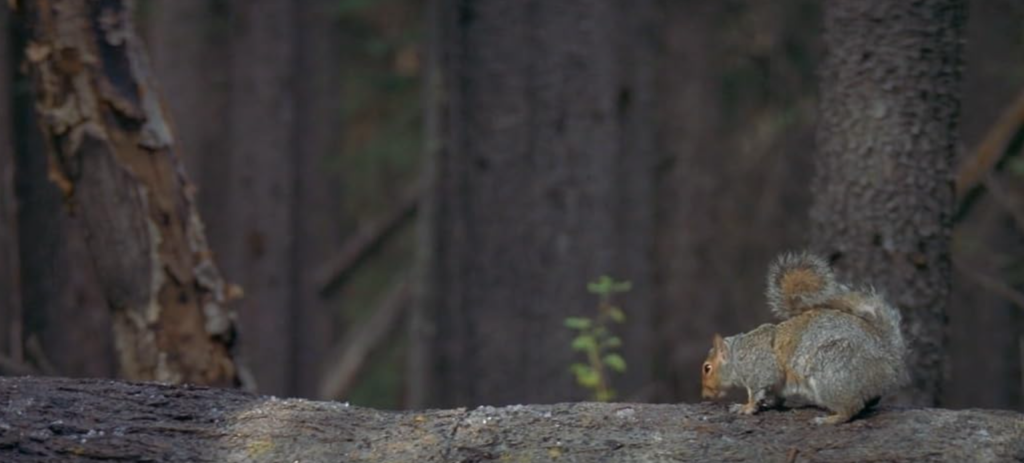
Figure 3- The squirrel heading along the branch towards the trap
Figure 4- Charles and Robert wait to see if the squirrel will go into the trap
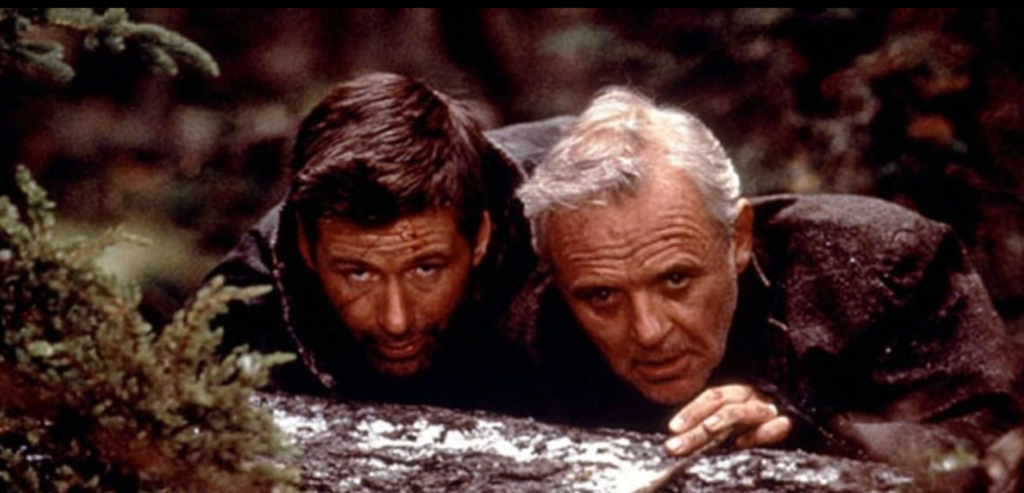
For example, Charles carefully crafts a trap made out of sticks and fir leaves. His hope is to bait a squirrel into the trap. The two men watch intently as the squirrel goes along the branch. The camera pans from an extreme close-up on Charles’ face, then Robert’s and then onto the squirrel. It continues like this until the squirrel becomes caught in the trap. This selection of shots demonstrates their anticipation as they wait for their prey. The close-ups mirror those of The Bear when he is hunting the men. The film seems to make reference to the similarity between The Bear stalking his prey and the humans theirs. However, it chooses to represent them in a different light. The ominous theme that is key to The Bear’s villainous portrayal is conveniently missing when the men hunt the squirrel. It is replaced by music that starts off rather tentative while the men wait to see if the trap succeeds and then bursts into a triumphant crescendo when the creature is captured. Furthermore, the scene where Charles becomes trapped under a pile of tree branches while The Bear attempts to claw at him is a perfect example of the contradictory representation within the narrative. The pile of branches is reminiscent of the squirrel trap however the tone of the scene is completely different. The ominous music has made its return and the film switches between Charles’ POV and Charles lying on the floor. By depicting The Bear as an overpowering force, looming force it makes Charles appear the underdog. Charles escapes and tells Robert “He’s a man killer!” however there is no suggestion that they themselves are squirrel killers! This would sound ridiculous although if we consider both animalistic and human survival the actions of The Bear and men are the same. It is only because as humans the accepted view is that we are superior to all other species.
Figures 5/6- Posters for The Edge
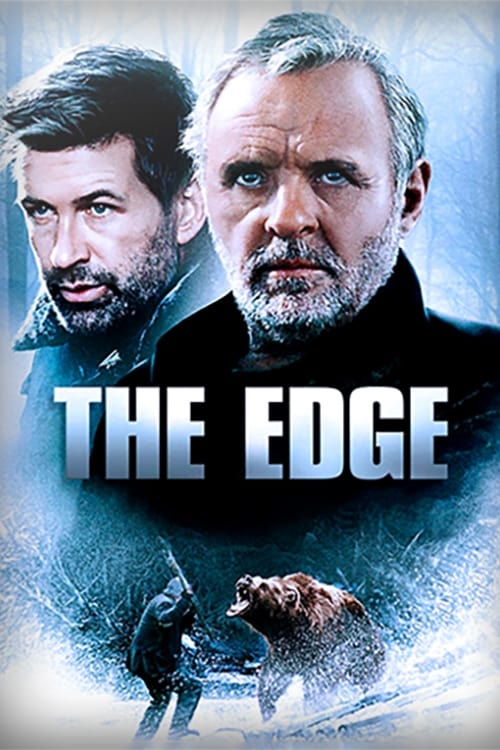
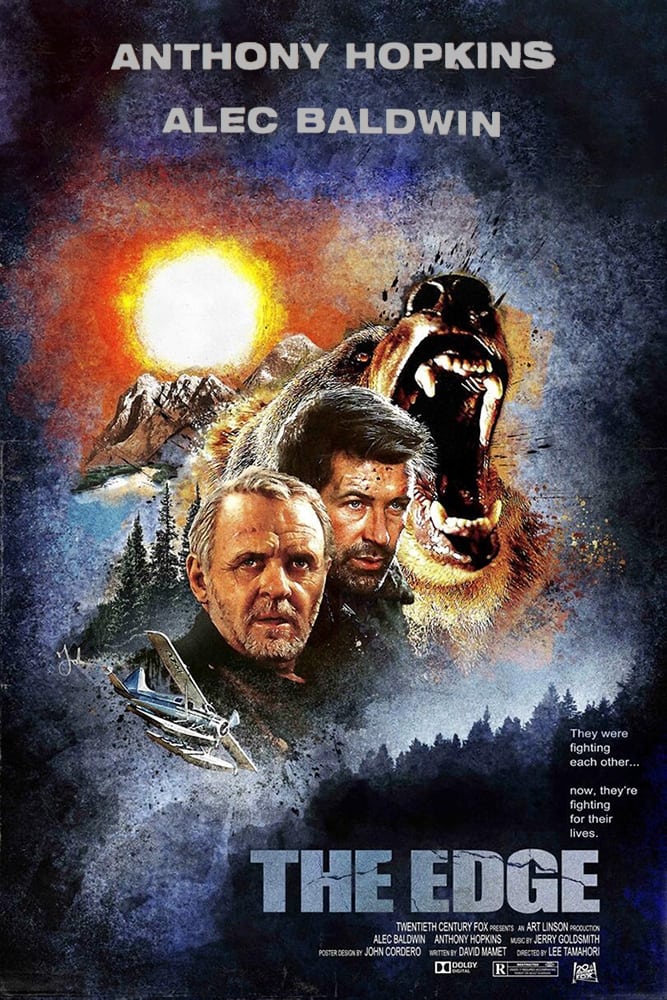
Chapman and Huffman write that ‘We often put humans on a pedestal, as unique and superior to all other animals: one of a kind; unlike any other animal’. Therefore, generally as species, we believe our life has a greater sanctity than that of other creatures. We are biased towards the survival of our own kind. Hence the film is simply characterising The bear as evil or the squirrel as there to be eaten because it is conforming to the accepted societal view of animals which is in some respects unimaginative.
Moreover, humans generally believe bears are scary and this adds to the bias people already have towards animals and the tendency to favour our own species. This is mainly because of the portrayal of bears as blood-thirsty killers in the media. In All Teeth and Claws: Constructing Bears as Man-Eating Monsters in Television Documentaries, Fuchs writes that bears ‘only become monsters when they encounter human beings’ and ‘The seemingly unbridgeable chasm which separates human from nonhuman animals…opens up a connection to monsters’. This suggests that humans fear bears partially because of a fear of the unknown. The fact we separate ourselves from other species means we often fail to understand them. Obviously, it would be ridiculous to claim that no bear has ever killed a person, however the average American is ten times more likely to be killed by a dog and 98% of those killed by bears are hunters. Therefore, there is no surprise that The Edge, like most media, depicts the bear in a negative way. It ignores the fact that The Bear is simply following its instincts and acting in the interest of self-preservation. Instead it perpetuates stereotypes to make the film more exciting for the audience and to conform to viewers’ predetermined idea of bears.
Furthermore, it is significant that The Bear uses his natural adaptations to try to overcome the men such as his abundant strength, sharp teeth, weight etc. Whereas the men use tools from outside of the natural world such as matches, knives, hooks etc. These objects, which Charles and Robert use to combat The Bear, are made in factories and on production lines. It feels almost like the man and beast are not competing on a level playing field but perhaps this is something that generally is the case. Adding to this sense of injustice, is the fact the men have chosen to enter The Bear’s domain resulting in the death of an innocent creature. Although they could not have predicted that the plane would crash, they were aware of the risk they were taking going on a flight in such a remote location. They have a negative impact on not only The Bear but its habitat and the other creatures living in the area. The men use fire they have made using matches as a defence multiple times. For example, when The Bear is attacking Stephen, both Charles and Robert wield fire near The Bear’s face. Another, very extreme example, is when Robert and Charles throw branches they have set on fire in order to create a circle of fire. This action will have a negative impact on the animal community in the area. Not only can fire injure or kill animals, it can also destroy vegetation communities meaning that the food source of further animals is destroyed.
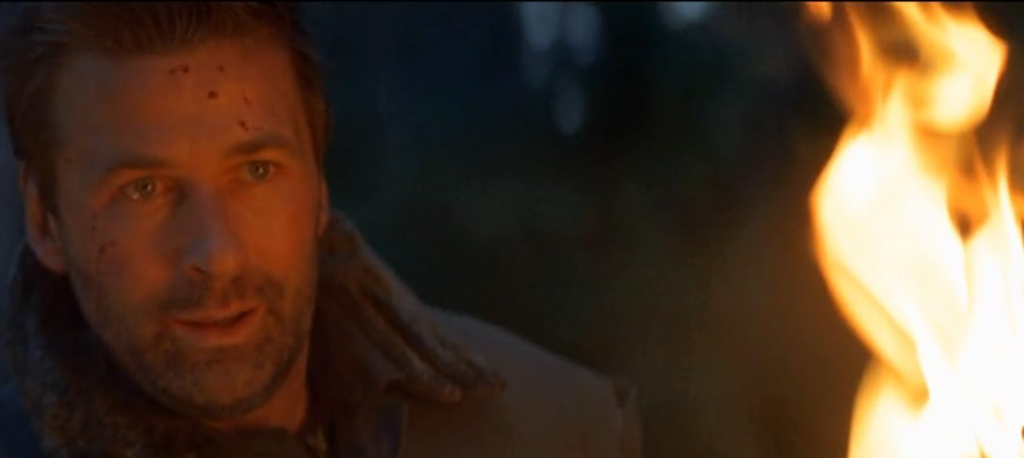
However, the film does not encourage us to view the narrative in this way and consider the impact on wider ecosystems; rather it infers that the men are simply using their superior human skills and tools to overcome The Bear. It could be argued that although the men use tools that are not available in the natural world they are using tools made by fellow humans or man-made machines and are just an extension of their natural skill set. Therefore, the combat between them and The Bear is perhaps not so unjust as it may have seemed at first. One of the reasons most humans believe they are ‘unique and superior to all other animals’ is because we are able to create objects and improve our own chances of survival as a result. Charles even manages to create new objects out of natural resources and what he has on his person. For example, he makes a compass using a needle and a leaf. Being able to use fire as a tool is something that sets humans apart from animals. Memorably in the The Jungle Book (1967), orangutan King Louie says to the human Mowgli “What I desire is Man’s Red Fire to make my dream come true”. Even if The Bear and the men are simply using their natural skills there is still something sad about the fact The Bear has been killed by those who have intruded upon his environment.
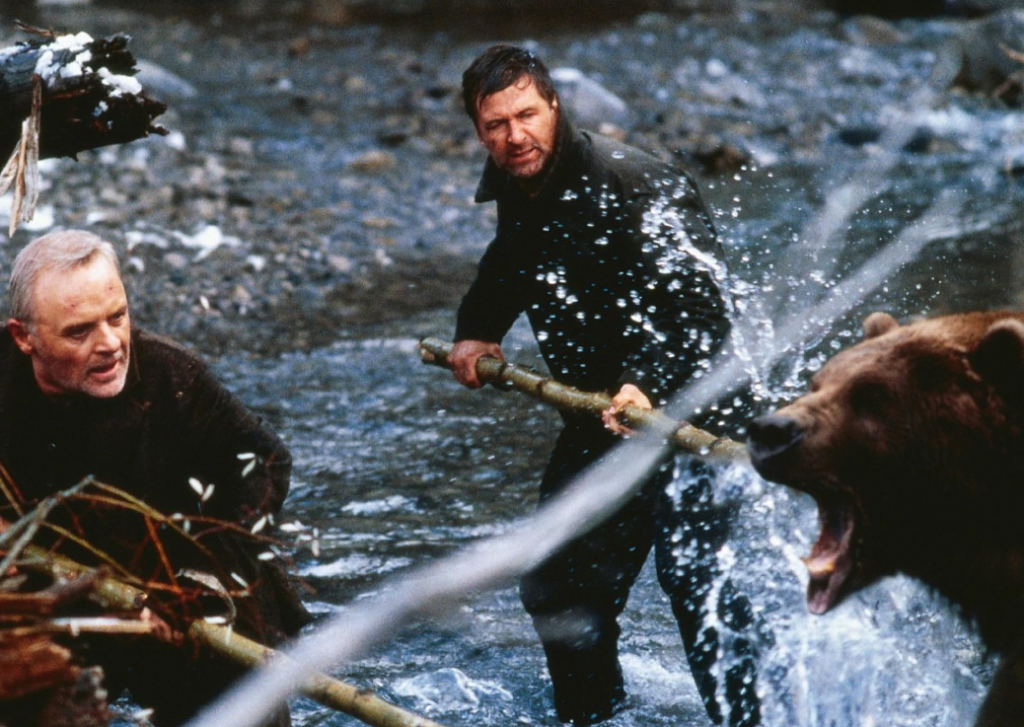
In some respects, the film glorifies the destruction of animals and their habitats. In the scene where the men are making the circle of fire, they are represented as being brave, strong and surviving against the odds. This is in a way true, as obviously you do feel sympathy for Charles and Robert however the scene certainly lacks any acknowledgement of the environmental damage they have caused. Another important example of this romanticisation of destruction is in the scene where the men kill The Bear. Charles and Robert begin fighting The Bear in a shallow section of a river. They use large, sharp branches, attempting to stab The Bear. Eventually, Charles is successful and eventually pierces The Bear with one of the sticks. This moment is represented as victorious for the men and as a display of great courage on the part of Charles. Yet again, in part it is, but there is a lack of acknowledgement of The Bear as a living, breathing creature who has been killed rather than simply a ‘monster’ that has been vanquished by the heroic humans.
Figure 10- Charles tries to stab The Bear
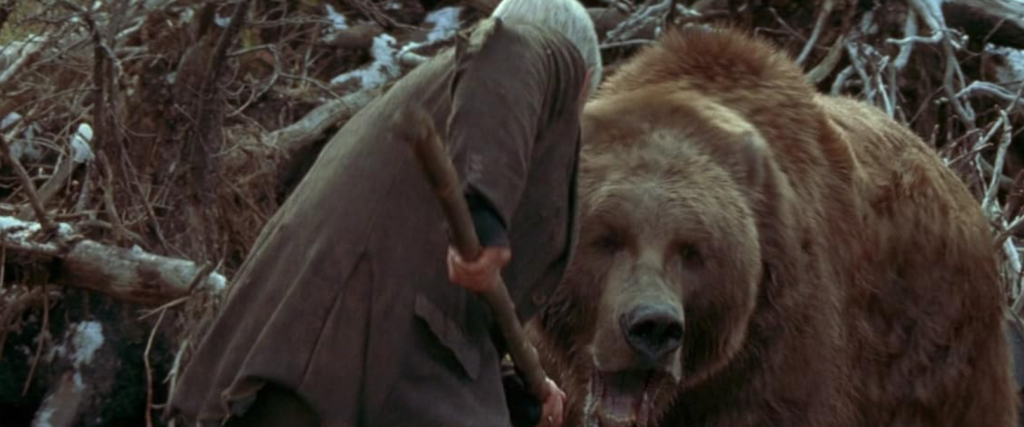
Overall, the film offers a clichéd representation of the relationships between animals and humans. Especially those between humans and so-called dangerous animals. However, although it is not the aim of the narrative it still has some interesting perspectives to offer. It allows us to consider the concept of survival and what that means to humans and animals. From this we are able to conclude that although The Bear’s survival may seem abhorrent to us i.e eating people it is really no different to the survival technique of Charles and Robert. Both parties are simply trying to stay alive. Additionally, we are given the opportunity to look further into whether or not Charles and Robert are using their natural skills to combat The Bear and if tools not available within the natural world are fair to use against The Bear. After some consideration, it is fair to surmise that tools such as knives, matches etc are fair to use as they were created by people. Nevertheless, it is still upsetting to see The Bear killed when Charles and Robert have entered his habitat which is something he has no control over. The destruction of animals and the environment is certainly glorified in the film even if accidentally. It would be interesting in the future to see a film about a so-called man-killing creature that combated the stereotypical portrayal presented in The Edge.
Further Reading:
Trout, A Paul, Deadly Powers: Animal Predators and the Mythic Imagination, 1st edn (New York, Prometheus Books, 2011)
Aaltola, Elisa, ‘Animal Monsters and the Fear of the Wild’, Fear, 5.1 (2002) <https://doi.org/10.5204/mcj.1944>
Carleton, Nicholas R, ‘Fear of the Unknown: One fear to rule them all?’, Journal of Anxiety Disorders, 41. (2016) <https://doi.org/10.1016/j.janxdis.2016.03.011>
Bibliography:
Primary Sources:
Tamahori, Lee, dir., The Edge (20th Century Studios, 1997)
Secondary Sources:
Chapman,Colin A, Huffman,Michael A, ‘Why Do We Want to Think Humans are Different?’, Animal Sentience, 23.1 (2018), 1-9 (pp. 3) <10.51291/2377-7478.1358>
Fuchs,Michael, ‘All Teeth and Claws: Constructing Bears as Man-Eating Monsters in Television Documentaries’, European Journal of American Studies, Special Issue: Animals on American Television, 1-13, (pp. 2-3) <https://doi.org/10.4000/ejas.12446>
Marshall, Frank, Congo (Paramount Pictures,1995)
NSW Department of Planning and Environment ,New South Wales Government,2023 <https://www.environment.nsw.gov.au/topics/fire/plants-animals-fire>, [accessed 11 January 2023]
IMDb, Featured Image, Digital Photograph, IMDb <https://www.imdb.com/title/tt0119051/> [accessed 11 January 2024]
IMDb, Figures 2,3,4,8,9,10, Digital Photograph, IMDb <https://www.imdb.com/title/tt0119051/> [accessed 11 January 2024]
IMDb, Jerry Goldsmith, 2024 <https://www.imdb.com/name/nm0000025/> [accessed 11 January 2024]
Reitherman, Wolfgang, dir., The Jungle Book (Walt Disney Studios Motion Pictures, 1967)
The Movie Database, Figure 1,Digital Photograph, The Movie Database, <https://www.themoviedb.org/t/p/original/gHIi9NgV2xeig3GPMnTkOckmJu1.jpg> [accessed 11 January 2024]
The Movie Database, Figures 5-6, Poster, The Movie Database
<https://www.themoviedb.org/t/p/original/gHIi9NgV2xeig3GPMnTkOckmJu1.jpg> [accessed 11 January 2024]
Youtube, Figure 7, Trailer/Video,Youtube <https://youtu.be/U0ZVuHntc-8?si=sFy975GCRTxSdgGy> [accessed 11 January 2024]
